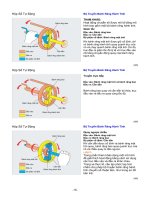Copolyme trung hop goc tu do
Bạn đang xem bản rút gọn của tài liệu. Xem và tải ngay bản đầy đủ của tài liệu tại đây (1.96 MB, 40 trang )
Copolymer
Classification by Monomer Composition
Copolymer
Homopolymer
Block
Graft
Alternating
Homopolymer
Consist of only one type of constitutional repeating unit (A)
AAAAAAAAAAAAAAA
copolymer
Consists of two or more constitutional repeating units (A.B )
Statistical
Alternating copolymer
Shown is an alternating copolymer
in which each of the ‘mers’
alternates in an ordered fashion
Statistical copolymer (Random)
When one type of ‘mer’ alternates
with no specific pattern, the
arrangement is known as a random
copolymer.
Alternating and random copolymers
with the same ‘mers’ can have very
different properties.
Copolymers – Graft Copolymer
When ‘sections’ of one type of polymer
is attached or ‘grafted’ to the main
chain of another polymer
Copolymers – Block Copolymer
When small groups of monomers are
attached to each other in alternating
fashion, the product is called a block
copolymer
Terpolymer
When there are three types of ‘mers’ polymerized
together it is known as a terpolymer.
Acrylonitrile Butadiene Styrene (ABS) is a
terpolymer of Acrylic, Butadiene rubber, and
Styrene.
This gives the Acrylic and Styrene added impact
resistance and the properties can be manipulated
by changing the amount of each of the individual
‘mers’
Các phương pháp tổng hợp
copolyme?
Đồng
trùng
hợp gốc
tự do
Điều kiện
phản
ứng
Copolymerization Kinetics
M1
M1
+
+
M1
M2
k11
k12
M1M1
Homo-propagation
M1M2
Cross-propagation
Terminal Model
Copolymerization Kinetics
M1
M2
M2
+
+
+
M2
M1
M2
k12
k21
k22
Homo-propagation
M1M2
Cross-propagation
M2M1
Cross-propagation
M2M2
Homo-propagation
Terminal Model
Copolymerization Kinetics
M1
M1
M2
+
+
+
M1
M2
M1
k11
k12
k21
M1M1
Rp11 = k11 [M1•] [M1]
M1M2
Rp12 = k12 [M1•] [M2]
M2M1
Rp21 = k21 [M2•] [M1]
Rp22 = k22 [M2•] [M2]
Terminal Model
Copolymerization Kinetics
The rate of disappearance of M1 and M2 can be expressed as:
d [M1]
- ——— = k11 [M1•] [M1] + k21 [M2•] [M1]
dt
d [M2]
- ——— = k12 [M1•] [M2] + k22 [M2•] [M2]
dt
Copolymerization Kinetics
The ratio of the two rates is then:
d [M1]
——— =
d [M2]
k11 [M1•] [M1] + k21 [M2•] [M1]
——————————
k12 [M1•] [M2] + k22 [M2•] [M2]
Simplify:
d [M1]
——— =
d [M2]
[M1]
———
[M2]
k11 [M1•] + k21 [M2•]
——————————
k12 [M1•] + k22 [M2•]
d [M1]
——— =
d [M2]
[M1]
———
[M2]
k11 [M1•]/[M2•] + k21
—————————— ……①
k22 + k12 [M1•]/[M2•]
Copolymerization Kinetics
Assume the Steady State Approximation:
The concentrations of M1• and M2• are constant
Therefore:
The rate of addition of M1• to M2 will equal
The rate of addition of M2• to M1
d [M1]
- ——— = k11 [M1•] [M1] + k21 [M2•] [M1] = 0
dt
d [M2]
- ——— = k12 [M1•] [M2] + k22 [M2•] [M2] = 0
dt
k12 [M1•] [M2] = k21 [M2•] [M1]
[M1•]
——— =
[M2•]
k21[M1]
———
k12[M2]
……②
Copolymer Equation
d [M1]
——— =
d [M2]
[M1]
———
[M2]
[M1•]
——— =
[M2•]
From ① and ②
[M 1 ]
1 r1
d[M 1 ]
[M 2 ]
[M 2 ]
d [M 2 ]
1 r2
[M 1 ]
k11 [M1•]/[M2•] + k21
——————————
k22 + k12 [M1•]/[M2•]
k21[M1]
———
k12[M2]
……①
……②
Copolymer Eq:
where
k 22
r2
k 21
k11
r1
k12
monomer
reactivity ratio
Copolymerization Kinetics
Copolymer Composition Equation:
d [M1]
——— =
d [M2]
[M1]
———
[M2]
Molar ratio of
the monomers in
the
copolymer
r1 [M1] + [M2]
———————
[M1] + r2 [M2]
Concentrations of
the monomers in the
feed
Meaning of r & Definition of f1, F1
Meaning of r
r1
r1 1
r1 0
characterizes the reactivity of the 1 radical with respect
to the two monomers, 1 and 2
then homopolymerization growth is preferred
then only reaction with 2 will occur
Define f1, F1
f1, f2 : mole fractions of monomers in feed
F1, F2 : mole fractions of monomers in polymer
[M 1 ]
f1 1 f 2
[M 1 M 2 ]
From ③, ④
F1
…… ③
r1f12 f1f2
F 1 1 F2
r1f12 2f1f2 r2 f2 2
……⑤
d[M 1 ]
d[M 1 ] d[M 2 ]
……④
• Nếu k11 >> k12 và k22 >> k21
r1 > 1 : M1* ưu tiên phản ứng với monome M1 (homopolyme hóa)
• Nếu k12 >> k11 và k21 >> k22
•r1 ˂ 1 : M1* ưu tiên phản ứng monome M2 (copolyme hóa)
Copolymerization Examples
• r1 = r2 = 1.0
– Monomers exhibit no preference for
homo-propagation vs cross-propagation
– Truly random
1.0
copolymer results
– F1 = f 1
0.8
– Ethylene /
0.6
vinyl acetate
F1
– Styrene/4-chlorostyrene
0.4
A
0.2
0.0
0.0
0.2
0.4
f1
0.6
0.8
1.0
Copolymerization Examples
• r1 = r2 = 1.0
• r1 = r2 = 0.0
– Monomers exhibit tendency to
cross-propagate
1.0
– Alternating
copolymer results
0.8
– F1 = 0.5
0.6
– Styrene / maleic
F1
anhydride
0.4
– TFE / ethylene
B
A
0.2
0.0
0.0
0.2
0.4
f1
0.6
0.8
1.0
Copolymerization Examples
• r1 = r2 = 1.0
• r1 = r2 = 0.0
• r1 and r2 between 0 and 1.0
– Common
– Cross-over point
• Azeotropic
polymerization
1.0
0.8
F1
0.6
A
0.2
0.0
B
C
0.4
0.0
0.2
0.4
f1
0.6
0.8
1.0
Alternating Copolymerization
Mean of Cross-over Point
F1 f1
At these crossover points the copolymer and feed compositions are the same
and copolymerization occurs without a change in the feed composition
Such copolymerizaions are termed Azeotropic copolymeriztions.
Condition of Azeotropic copolymeriztion
d[M 1 ] [M 1 ]
and
d[M 2 ] [M 2 ]
F1
[ M 1 ] (r2 1)
[ M 2 ] (r1 1)
d[M 1 ]
[M 1 ]
f1
d[M 1 ] d[M 2 ] [M 1 ] [M 2 ]









